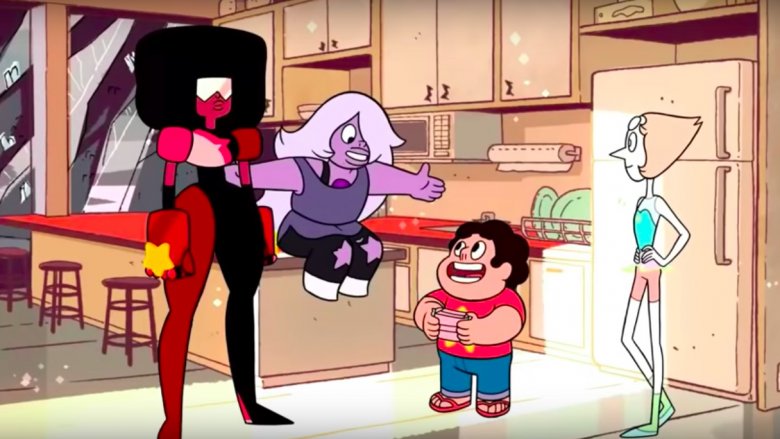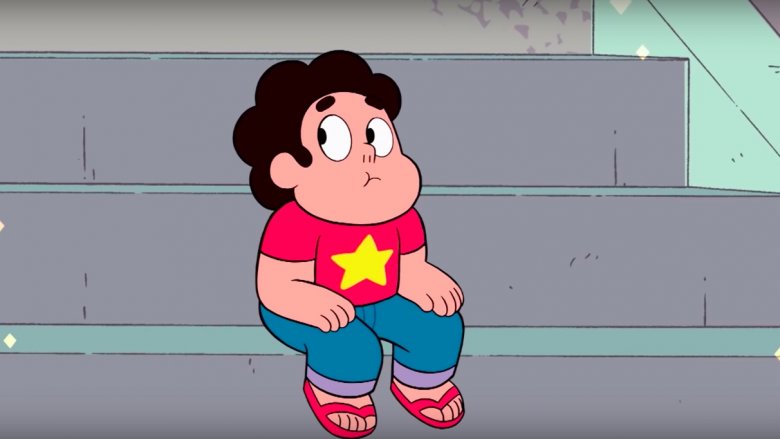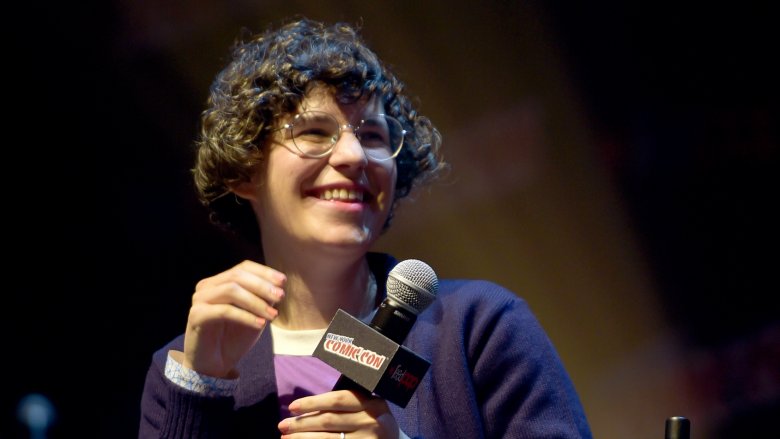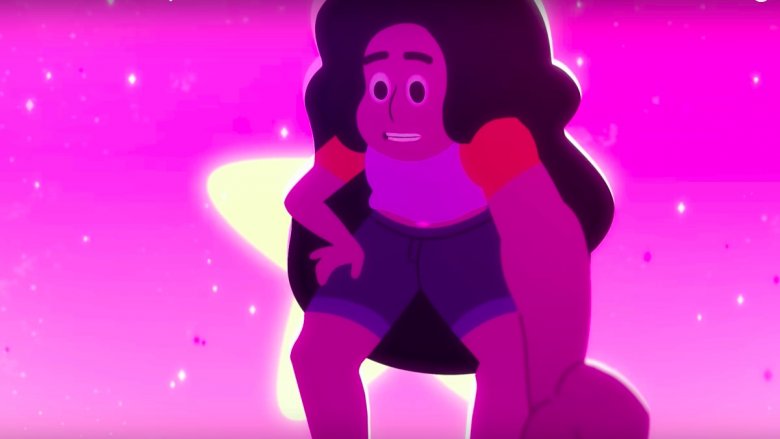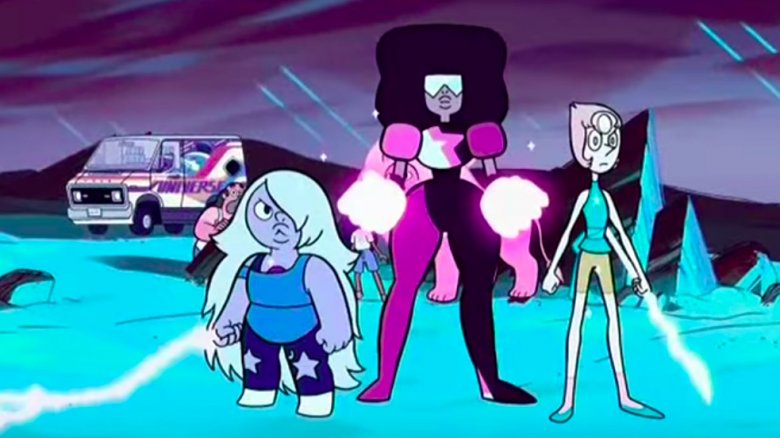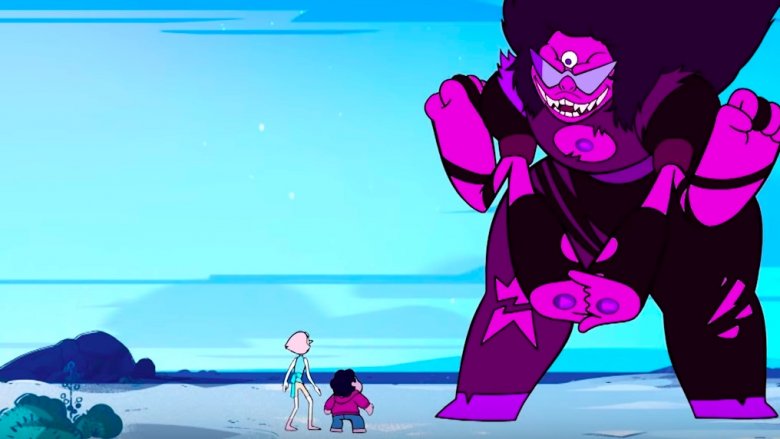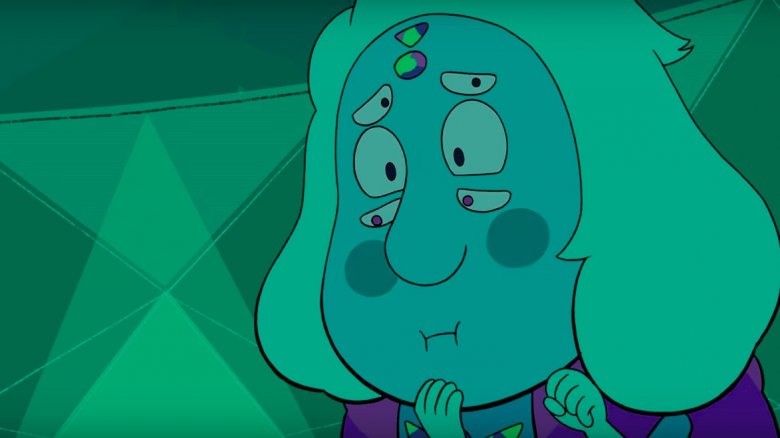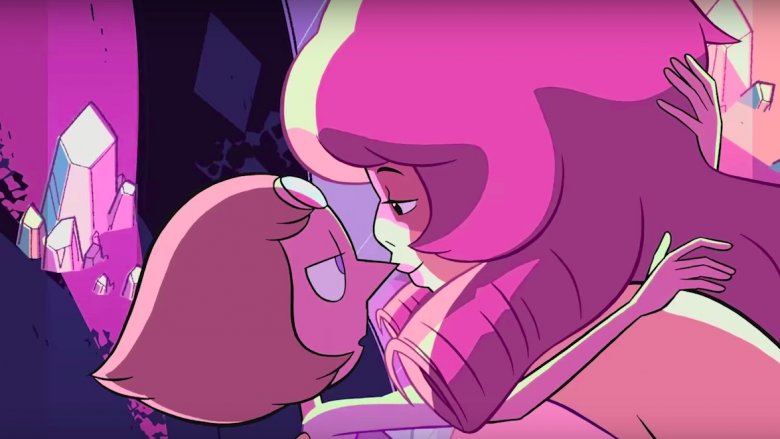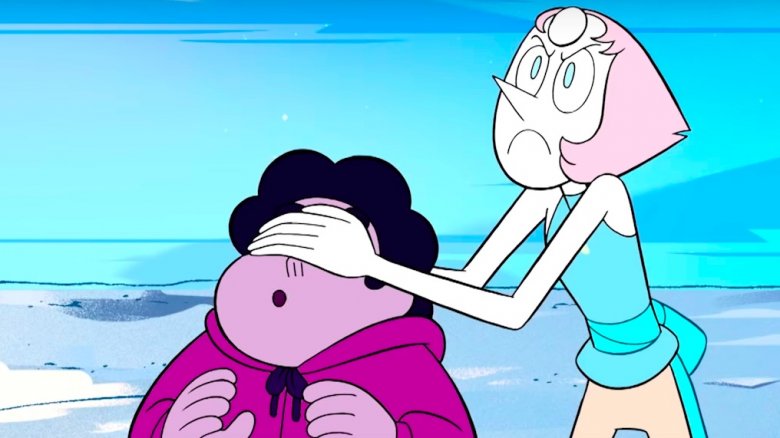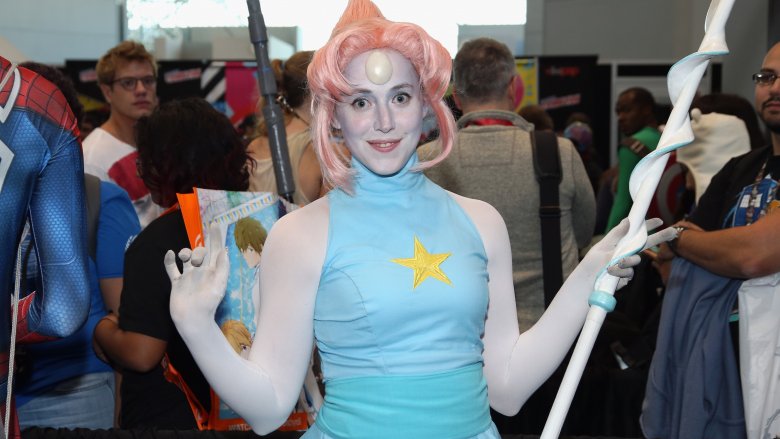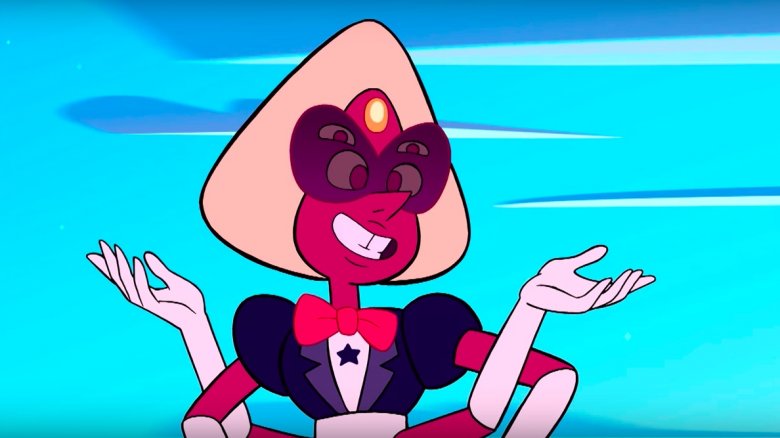The Untold Truth Of Steven Universe
Long, long ago, like in the '70s, kids shows were either vapid and violent with no message whatsoever, or full of syrupy sweet morals that would have been decent on pancakes but didn't really address any of the real challenges of childhood. Then in 2005, the PBS kids show Postcards from Buster featured a gay couple and the television-watching universe lost its collective mind. Subsequent attempts to positively portray LGBTQ people in kids' programming were met with protest and horrified lamentations. ("What about the children?!") But cartoon producers soldiered on, and then in 2013 the "queerest animated show on TV" was born.
For the uninitiated, Steven Universe seems like any other kids' show about a boy with superpowers and his trio of alien sidekicks. But the storyline gives showrunners a fantasy framework for talking and thinking about LGBTQ issues in a way that is both subtle and meaningful, which is pretty awesome for gender nonconforming kids even if it's not so awesome for people who are terrified of gender nonconformity. The cool thing about Steven Universe, though, is that it's so much more than just the sum of all its controversies. It's got depth, heart, and some untold truths, too.
Steven is a real person, except for the part where he has a magical gemstone in his belly button
The title character Steven is a charming, chubby, curly-haired kid who's pretty sure all the universe's problems could be solved if we could just all sit down and talk about it. He's got such an honest and resonating personality that you just know he must be based on someone real, and you're right — not only was Steven inspired by show creator Rebecca Sugar's younger brother Steven, but the "real" Steven actually works on the show as a background artist.
Sugar told Entertainment Weekly that at its core, the show is about her brother: "The two of us growing up were best friends. ... That's the feeling that I want to give to everyone, the feeling of having an unconditional friend that's always there for you, because that's really what he was." The show's Steven has qualities based on the real Steven — he's an emotionally supportive person who tries to be a role model for others. Of course the real Steven doesn't have magic powers and friends who are aliens, but that's beside the point. The action, the fantasy, the space travel, and the gender politics are really just an (important) backdrop for Sugar's main source of inspiration. "At the end of the day," Sugar told Entertainment Weekly, "I really want to do something that's dedicated to my brother."
Rebecca Sugar once wrote for another show about a boy hero
If Steven Universe seemed a little familiar to you the first time you watched it, that's probably got something to do with its heritage. Rebecca Sugar used to work on another Cartoon Network program called Adventure Time, which is also a weird fantasy story about a boy who wants to save the world. Sugar told IndieWire that she credits Adventure Time with teaching her how to make television with universal appeal.
Sugar wrote 21 episodes of Adventure Time and was also responsible for a lot of the music on the series — she wrote and cowrote some of its classic songs, such as "Daddy, Why Did You Eat My Fries?" a ballad sung by a 1,000-year-old vampire to her green-skinned, pointy-eared, Lord of Evil father (which incidentally was nominated for an Emmy along with the episode it appeared in). In 2018 she briefly returned to the show to write a song for Adventure Time's final episode.
Adventure Time wasn't quite as progressive as Steven Universe, but Sugar did write the gender-swapping episode "Fionna and Cake," which in a way could be seen as paving the way for Steven Universe and its very progressive treatment of gender roles and LGBTQ issues.
A bunch of firsts
You only have to watch a couple of episodes of Steven Universe to know that it's unique. And that's reflected in its legacy of firsts — according to the AV Club, it was the first Cartoon Network program to have a woman creator, it featured the first-ever same-sex wedding on a children's TV show, and it was the first kids' show to feature a gender nonbinary character who uses they/them pronouns.
If you're still reeling from all that progressiveness it's worth noting that the show presents its gender-bending ideas through the lens of a fantasy universe. The "same-sex wedding" was between two characters who belong to an alien race called "gems," which has only a single gender — if you can even call it "gender" since the gems are essentially living rocks in humanoid form. That should soften the blow for someone who might otherwise have a problem with a same-sex wedding on a kids show, although in the year 2018 that's really not a blow that should still need softening.
Same for the gender nonbinary character, whose name is Stevonnie. Stevonnie is a fusion, or a single entity created by combining the forms of two other characters. Technically, Stevonnie really is a "they," since the character is a fusion between Steven and his best friend Connie. On the other hand, Stevonnie is sometimes androgynous, sometimes more male than female, and sometimes more female than male, and clearly in need of a gender-neutral pronoun.
It's really just baby steps
On Steven Universe, the gems aren't human and therefore don't have the same physical framework as humans do, so gender is entirely internal. Rebecca Sugar told NPR the gems are "nonbinary women," but "they're coded female ... a little more representative of nonbinary women."
Sugar wrote the gems that way because it was something she'd never seen on television before, and because she herself identifies as a nonbinary woman. "[It's] been really great to express myself through these characters," she told NPR, "because it's very much how I have felt throughout my life."
At first, Steven Universe's treatment of gender and LGBTQ issues seems very progressive and groundbreaking, but it's really baby steps. Sugar gets some flak even from members of the LGBTQ community, who believe that by relegating same-sex relationships and gender nonbinary traits to the alien characters, the show only tiptoes around the issues and falls short of really giving LGBTQ kids the role models they need.
The criticisms fail to take into account the realities of modern television, though — it may be true that the medium is in desperate need of strong LGBTQ characters, but it's also true that there's still a lot of hostility toward including that kind of representation in children's television. For the message to truly get where it needs to go, it might actually need to do some tiptoeing.
Sugilite is a Hindu goddess
The gem fusions are a gigantic presence in the Steven Universe universe — autonomous entities that are formed when two gems combine to create a single being. The fusions are usually (with a few exceptions) really large and really scary, with extra eyes, arms, and legs.
One of the first gem fusions viewers were introduced to was Sugilite, who is a fusion between Garnet and Amethyst, and is described as being "a little unstable." In fact Sugilite is enormous, has five eyes, four arms, and likes to smash things with her magic wrecking ball. According to 3,000 Facts About Animated Shows by James Egan, it's no accident that Sugilite resembles a Hindu goddess — she's actually based on Kali, the goddess of destruction. Funnily enough, Kali also has four arms and is "a little unstable," though she tends more toward decapitation as a hobby and enjoys wearing the severed body parts of her victims as a fashion statement.
Nontraditional families, polyamorous relationships and more
As long as you're going to have a kids' show that tackles gender identity, you might as well also broach some other issues that most kids' shows have never in a million years thought to bring up on screen. According to SheKnows, the show uses fusion as a metaphor for a romantic relationship, but sometimes the fusions are troubling. In one episode, an enemy gem forces another gem into a fusion against her will, and it's pretty obvious their union is a metaphor for rape and abuse. Grief and loss play a big part in the show, too — Steven's mother "gave up her physical form" to bring him into the world, so he's constantly living in the shadow of someone who was loved by everyone around him but who he never had the opportunity to know.
There are other less heavy discussions of things like nontraditional families (Steven is being raised by three women, and his father, though present, does not live with him). There's even a polyamorous relationship — a gem called Fluorite is revealed to be a fusion between multiple gems. If that seems like it might be a little too much for a kids' show, keep in mind that there's no real discussion of exactly what a polyamorous relationship is or how complicated that might get, it's simply a footnote: Fluorite explains that she's a fusion between six different gems, "Maybe more, if we meet the right gem."
All good things must be censored
So bearing in mind that the Gems are genderless living rocks and can really only be very loosely compared to humans, it seems there are some humans who still just can't get their minds around the idea that two female-coded characters (who are from a culture where there are literally no males except for one 12-year-old kid) might have feelings of affection toward each other, and worse, that some vulnerable, impressionable child might see two female-coded characters having feelings for each other and, who knows, decide to become a genderless living rock in a romantic relationship with another genderless living rock or something.
According to The Guardian, this terrifying, terrifying prospect evidently spooked the censors at Cartoon Network UK, who decided not to air a scene in which two gems embrace and exchange a romantic gaze. Yes, Cartoon Network UK evidently thought that hugging and eye contact was just going too far.
It's probably fair to mention that the network also once censored a kiss between two heterosexuals, so it's possible that it's just intimacy in general that worries the censors, and not specifically the same-sex nature of the interaction. Still, the censorship came across that way, especially since it wasn't a kiss that got nixed but rather the suggestion that there might possibly be a kiss at some point off screen somewhere, which really doesn't seem like equal treatment.
Eek but the children!
You probably don't have to be told that the mere existence of Steven Universe really irks a lot of people. After all, it's not just a matter of "What if children see it?" because it's actually for children, and eek, the gay agenda. A 2015 Change.org petition complained that "same sex relationships is not a topic that should be discussed in childrens [sic] programming." It got a whopping 151 signatures. In the same year the socially conservative LifeSiteNews.com lamented that Steven Universe was a part of a growing trend of "pro-gay" cartoons. "Steven is half-boy, half alien 'gem' and raised by three alien gem mothers, two of whom are romantically involved," wrote critic Lianne Laurence, thus proving that you don't actually have to watch a show in order to feel qualified to critique it.
The good news for Steven Universe fans is that there aren't a lot of movements out there dedicated to abolishing this quirky, sweet, groundbreaking program — it even seems to have escaped the notice of One Million Moms, the fundamentalist boycott mobilization group known for complaining about pretty much everything on TV. It could be that the portrayal of the same-sex relationships has just enough elements of fantasy to let it fly under the radar, while protests tend to center on more human portrayals of same-sex relationships.
Sometimes rabid fans can be a little too rabid
Every controversial show has baggage, whether it's protesters who don't like the content or rabid fans who know exactly what they want from the show and refuse to take anything less. According to io9, Steven Universe storyboard artist Lauren Zuke had to delete her Twitter account after she was repeatedly harassed, not by parents who think the show goes too far but by fans who think the show isn't going far enough.
Now if it wasn't for the fact that harrassment sucks and should not be a thing, the controversy was almost humorous — kind of like if Team Edward and Team Jacob had a showdown where they all threw hot coffee at each other and typed mean words really hard. Because let's just take a step back for a moment and remind ourselves that FICTION.
Some fans were mad because Zuke seemed to be supporting a relationship between characters Lapis and Peridot, when what they really wanted to see was a relationship between Amethyst and Peridot. So, that. And then there was the other time when a fan artist was repeatedly and ruthlessly harassed by fans who thought she was drawing characters with the wrong proportions/body types. So it seems Steven Universe is a show that's capable of inflaming the emotions of not only those who don't agree with its message but also those that do.
The show is maybe kind of racist
Steven Universe gets gender and LGBTQ issues right, but critics say it's not doing so well when it comes to race. According to Pop Matters, the show misstepped when it portrayed Sugilite, the Kali-like fusion between two gems coded to be persons of color, as out of control and destructive. And then it misstepped even more when it portrayed lighter-skinned Pearl as the more sensible character, the one that reasons with her sometimes "unstable" friends. And to make matters worse, the fusions that involve Pearl are always more rational and stable than the fusions between purely black-coded characters, and they also behave as if they are superior to those other fusions.
Without getting into the heads of the show's writers, it's really hard to say whether the characters are just blatantly stereotypical because they're consciously written that way — which seems doubtful, since the writers are inarguably open-minded and progressive in pretty much every other way. More likely, the problems with race and representation come from a place of ignorance and an unfortunate lack of sensitivity. Some fans even think the criticism is entirely misplaced, and critics are reading more into it than is actually there.
One thing we can all agree on, though, is that Steven Universe could use a black woman writer — without one, it will be difficult if not impossible for showrunners to correct the damage that's been done — whether deliberate or otherwise.
